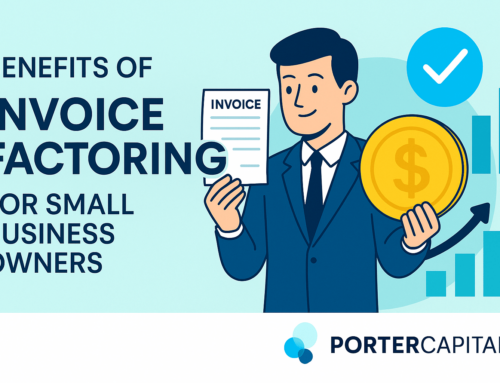If you own a company, getting paid by your customers or clients is important if you want to keep your doors open. While some clients pay on time, some tend to run behind. Keeping track of who pays and when is crucial to make sure you are fairly compensated for your work and can take action to try to recover any money owed.
An aging schedule is one accounting tool that can help you determine which accounts receivable are overdue, how long they’ve been that way and how much you’re owed. Having this information in hand empowers you to make important decisions about what to do next to protect the future of your company.
Filling Out an A/R Aging Schedule?
Discover how Porter Capital can simplify your A/R aging schedule and provide quicker access to capital.
What Is an Aging Schedule?
An accounts receivable (A/R) aging schedule is an accounting table listing the accounts receivable for a company organized by due date. This table is usually available as part of an accounting software package, though you can also create it in a simple spreadsheet yourself.
The aging schedule lists details for each account receivable for a company, including the customer’s name, the amount due and how long an invoice has been overdue.
A simple A/R aging schedule will usually have the names of clients or customers down the right hand of the chart, accompanied by the amount they owe. Along the top of the chart will be the time frame the company wants to track. Usually, this will be divided into 1-30 days past due, 31-60 days past due, 61-90 days past due and 90+ days past due.
The aging schedule lets you see whether your clients and customers are paying you on time.
How Is an Aging Schedule Used?
An aging schedule lets you see who is paying on time and which invoices are overdue. It organizes receivables by due date so you can see at a glance which ones may be a concern. You can use this information in a few ways:
- To get paid. If you see that an account is outstanding, you can send reminder notices or attempt collection. An aging schedule makes sure no overdue invoices slip through the cracks and allows you to pursue unpaid accounts.
- To change credit policies. If you notice many customers or clients are late with paying invoices, it may be time to update your processes. Perhaps you need to send reminders about unpaid invoices more often or even start charging interest on overdue amounts. An A/R aging schedule lets you spot patterns so you can act.
- To evaluate clients. An aging schedule highlights customer patterns as well. You might notice some clients pay on time while others routinely do not. By examining what on-time clients have in common, you can focus your marketing efforts on those types of customers. You may also choose to spend less time and focus on those who are slow to pay.
- To spot cash flow issues. If your aging schedule shows multiple unpaid invoices, you can forecast cash flow issues. This information lets you come up with a plan, such as relying on factoring, to make sure you can make payroll and meet other obligations. It also equips you to be strategic about what clients to take on and what investments in your business you may wish to make next.
- To evaluate financial performance. Analysts, accountants and managers use A/R schedules to evaluate an organization’s financial and operational performance. Having numerous accounts past due may indicate an operational issue that needs to be addressed and support a case for maintaining more liquid assets.
- To implement credit collection policies. An A/R aging schedule lets you determine the right course of action when an invoice is unpaid. For accounts just slightly late, you can send a polite reminder. For clients with large invoices that haven’t been paid for three months or more, you may consider professional collection or even legal action. Seeing the numbers clearly can help you determine the most appropriate response.
- To target credit risks. Some customers and clients simply routinely fail to pay their bills. Collection actions are not always motivating enough to drive payment, and some bad actors find they can ignore bills with little consequence. If you don’t check credit scores before working with customers, aging schedules let you spot nonpayers so you can terminate your relationship with them.
The Importance of Creating an Aging Schedule
You need to make money for your offerings in order to pay your team and keep providing goods or services. When clients do not honor their payments, it can have a domino effect:
- You spend more time chasing overdue accounts, and less time growing your company.
- You may experience cash flow problems, which may limit the new opportunities you may feel you can take on.
- If you take on debt to cover cash flow problems, you will now be paying interest, which leads to even greater financial challenges.
Nonpayment can hurt your business. Unfortunately, the longer a customer or client doesn’t pay you, the more cash flow problems you may face. In addition, the less likely it is that the account will eventually be paid in full.
An A/R aging schedule lets you spot trends so you can stop working for nonpaying clients and act to reduce your number of delinquent accounts. If a customer has failed to pay on time the past three times you’ve worked together, for example, you may consider halting further work until that company can pay in full. You may even start evaluating client credit scores before working with new customers to help prevent the same problem in the future.
Many companies create aging schedules for internal review. In some cases, investors and lenders may ask to see a company’s A/R aging schedules to evaluate its financial position, operational health and working capital management. In these cases, an aging schedule can determine whether a company gets a loan or funding. Auditors can also ask to see a company’s aging schedule to estimate how much a firm’s receivables are worth.
Many companies with unpaid accounts receivable choose to work with a factoring company for funding to improve cash flow. If you decide on this course of action, a factoring company will use your aging schedule to determine your factoring rate.
An Example of an A/R Aging Schedule
Let’s look at an example:
| Customer | Total due | Current (less than 30 days since invoice) | 31-60 days past due | 61-90 days past due | Over 90 days past due |
| Acme | $20,000 | $5000 | $15,000 | ||
| That Co. | $5,000 | $500 | $500 | $4000 | |
| XYZ Inc. | $1000 | $1000 | |||
| ABC Corp. | $90,000 | $80,500 | $9,000 | $500 | |
| Some LLC | $20,000 | $3,000 | $2,000 | $15,000 |
This chart shows $136,000 in total is outstanding. It also shows that half of the invoices are more than two months past due.
Accounting software can create an aging schedule for you, but learninghow to fill out an A/R aging schedule yourself is simple:
- Write down the names of every customer or client with an outstanding invoice.
- Next to each client, write down the total amount of invoices and accounts receivable due.
- Indicate how far past due each amount owed is on the schedule.
You can also create a total amount due column or calculate the percentage of accounts overdue by three months, 61-90 days and so on.
How Porter Capital Can Help
Unfortunately, not all accounts receivable are paid on time. Clients and customers may miss or forget about an invoice, or they may be unable to pay. Missed payments can have a direct impact on your business and your ability to serve other customers.
Getting a loan to cover expenses in this situation can be less than ideal. You need excellent credit to get credit from a bank, and the process is often involved and lengthy. You may not be able to get the money you need in time to make payroll or pay your own company bills.
Porter Capital offers funding for all the ways you do business. Our accounts receivable financing and invoice factoring services allow you to receive immediate funds for outstanding invoices, which can help you limit cash flow issues. Also known as AR financing, this solution is used by companies across many industries. Unlike a form of equity, AR financing does not require a dilution of ownership, and unlike a loan, it will not negatively impact your balance sheet.
Our team has over 30 years of experience and can offer funding quickly, often within 24 hours. We fund up to 85-95% of the invoice value, minus our 1-3% fee. We’re always fully transparent about costs and available to answer all your questions — the company owner is in the office every day to give our clients full confidence in our commitment to their operations.
Porter Capital offers additional free services as well, including cash posting, full collections and a credit department. If an aging schedule has shown you may be facing a cash flow challenge, contact Porter Capital to review your options.




